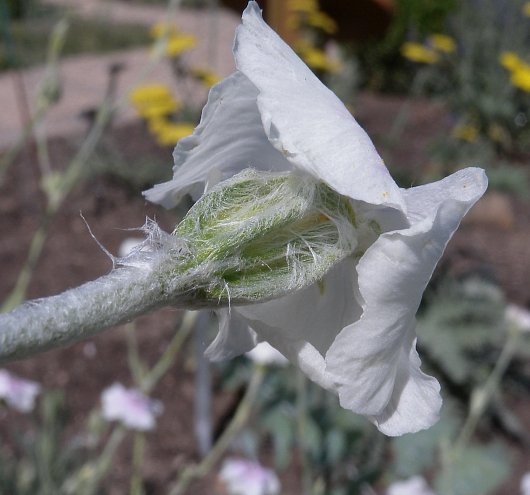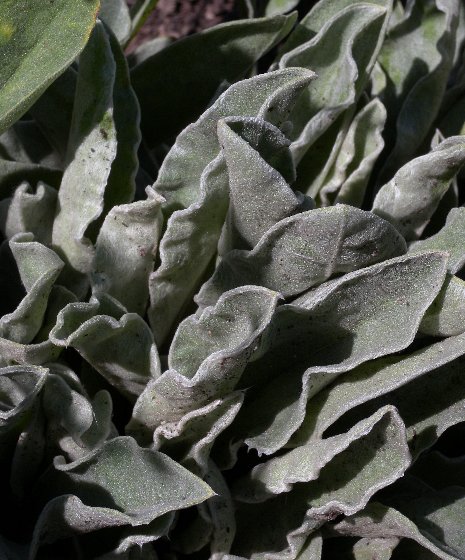
The upper stems terminate in flowers that are usually solitary, or the flowers may occur in groups of 2-3. Each flower is 1–1¼" across, consisting of 5 reddish purple, pink, or white petals, a whitish green calyx, 10 stamens, and an ovary with 5 styles. The petals are obovate-orbicular in shape, partially overlapping, and somewhat floppy; their outer margins are irregular and sometimes slightly notched. The calyx is about ¾" long, ellipsoid in shape, and open at its apex with 5 teeth. The calyx has 5 prominent longitudinal ridges and 5 smaller longitudinal ridges; it is densely covered with white-woolly hairs. The teeth of the calyx are narrowly triangular with twisted and recurved tips. The pedicels of the flowers are ½–6" long and similar to the stems, except they are even more white-woolly. A pair of leafy bracts occur along these pedicels; these bracts are up to ½" long, lanceolate in shape, and sessile.

The blooming period occurs during the summer and early autumn for about 1½–3 months. There is no noticeable floral scent; the flowers are diurnal. Afterwards, the flowers are replaced by seed capsules about ½" long or slightly longer; these capsules are ellipsoid-ovoid in shape and open at their apices, where they are 5 toothed. Each capsule contains numerous small seeds about 1–1.5 mm. in length. These seeds are reniform-orbicular in shape, somewhat flattened, and tuberculate (with a minutely warty or pebbly surface). The root system consists of a taproot. This plant spreads by reseeding itself.
Cultivation: The preference is full or partial sun and mesic to dry conditions; different soil types are tolerated, including those that are loamy or stony. As the blooming season progresses, this plant becomes rather tall and lanky.

Range & Habitat: Mullein Pink rarely naturalizes in Illinois; such wild plants have been found in only a few counties of the state (see Distribution Map). Mullein Pink was introduced into North America as an ornamental garden plant; it is native to SE Europe and Turkey, where it is typically found along rocky slopes. In Illinois, wild plants of Mullein Pink are found in various disturbed habitats, including roadsides, fallow fields, and waste areas. Mullein Pink is also cultivated in flower gardens. While this plant occasionally reseeds itself, it is not considered aggressive in Illinois.
Faunal Associations: Little is known about the floral-faunal relationships of this plant in North America. The flowers are cross-pollinated by butterflies, where nectar is available as a floral reward. A wool carder bee, Anthidium maniculatum, gathers the hairs of Mullein Pink while constructing the lining of its nests. While this is a European bee, it has been found in Michigan and other areas of the United States (O'Brien et al., 2012). It is possible that other wool carder bees (Anthidium spp.), whether native or introduced, also use this plant. White-tailed Deer usually avoid the densely hairy foliage of this plant.

Photographic Location: An herbal garden at Meadowbrook Park in Urbana, Illinois.
Comments: The white-woolly foliage, showy flowers, and dichotomously branched stems provide this plant with a distinctive appearance. As a result, it is easily distinguished from other species that occur in Illinois. Many cultivars of Mullein Pink have been developed; these differ from each other primarily on the basis of flower color. Another common name of this plant is Rose Campion, while an alternative scientific name is Lychnis coronaria. Different authorities are still divided as to whether this species should be assigned to the Lychnis or Silene genus. The taxonomy of Mohlenbrock (2014) has been followed here.